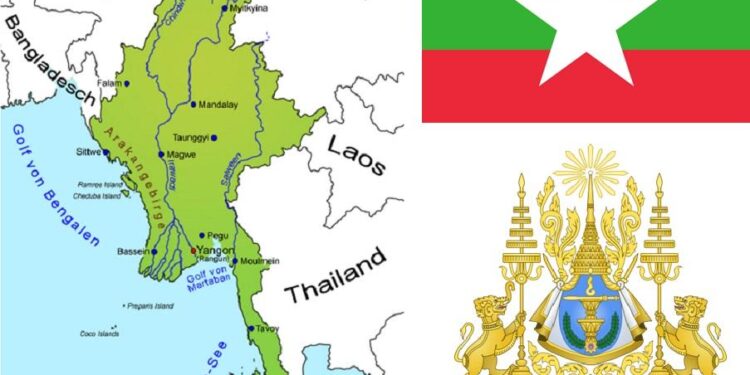Myanmar Incinerates $300 Million Worth of Seized Drugs in Intensified Campaign Against Narcotics
In a decisive move to dismantle the illicit drug trade, Myanmar officials recently destroyed a massive stockpile of confiscated narcotics valued at an estimated USD 300 million. This high-profile event highlights the country’s ongoing struggle against a flourishing drug industry that has drawn widespread international scrutiny. With substances such as methamphetamines and opiates increasingly permeating both local and global markets, this act underscores Myanmar’s determination to confront the persistent drug crisis undermining regional security and public health. The incineration serves not only as a stern warning to traffickers but also as a clear demonstration of the government’s resolve in its multifaceted campaign against organized crime and substance abuse.
Myanmar’s Resolute Stance in the Fight Against Drugs: A Step Toward National Stability
Myanmar’s recent destruction of narcotics worth approximately USD 300 million marks a significant milestone in its efforts to regain control over regions long dominated by drug cartels and insurgent groups. The seized drugs included large quantities of methamphetamine pills—commonly known as “yaba”—and various opiates, which have contributed heavily to public health crises across Southeast Asia. This operation reflects more than just law enforcement success; it signals an attempt to restore social order and economic stability within communities deeply affected by addiction and illicit trade.
Facing mounting pressure from international partners, civil society organizations, and domestic advocates for reform, Myanmar is adopting comprehensive strategies aimed at addressing both supply-side interdiction and demand reduction. These include:
- Empowering Local Communities: Initiatives focused on education, vocational training, and alternative livelihoods seek to reduce dependence on narcotic economies.
- Regional Collaboration: Enhanced cooperation with neighboring countries like Thailand, China, Laos, and India aims to disrupt cross-border trafficking networks.
- Reforming Law Enforcement: Strengthening transparency, accountability, and operational capacity within police forces dedicated to anti-narcotics operations.
Despite these promising developments, Myanmar’s complex socio-political environment demands sustained commitment beyond symbolic acts. Long-term success hinges on building equitable institutions that can withstand entrenched criminal influences while promoting inclusive growth.
Economic Repercussions of Large-Scale Drug Destruction on Myanmar’s Underground Economy
The elimination of narcotics valued at $300 million inevitably disrupts Myanmar’s shadow economy tied closely with illegal drug production and distribution. In the short term, this removal reduces supply availability which may cause street prices for methamphetamines or heroin derivatives to surge sharply—a phenomenon observed previously when major busts occurred along the Golden Triangle region.
However, such scarcity often invites opportunistic actors seeking entry into lucrative markets left temporarily underserved by traditional suppliers. Consequently, while seizures weaken existing trafficking rings momentarily, they rarely eradicate demand or prevent new players from emerging without complementary socio-economic interventions.
On a community level where many depend indirectly or directly on income generated through poppy cultivation or synthetic drug manufacturing facilities—especially in remote border areas—the sudden loss can exacerbate unemployment rates significantly. Without viable alternatives provided through government programs or NGO support systems focusing on agricultural diversification or small business development—as seen successfully implemented in parts of northern Laos—the risk rises for increased poverty-driven crime or social unrest.
Therefore it is critical that eradication efforts be paired with sustainable development policies designed not only to suppress illegal activities but also foster resilient local economies capable of transitioning away from dependency on narcotic revenues.
Comprehensive Strategies To Enhance Anti-Narcotic Efforts And Foster Community Resilience
To build upon recent successes like this monumental destruction event effectively requires an integrated approach combining enforcement with prevention measures rooted deeply within affected populations:
1. Strengthening Cross-Border Law Enforcement Cooperation:
The fight against transnational trafficking necessitates robust partnerships between Myanmar’s agencies alongside counterparts across Southeast Asia—including joint intelligence sharing platforms—and investment into advanced training programs equipping officers with modern investigative techniques.
2. Mobilizing Grassroots Participation:
Cultivating community ownership through awareness campaigns led by trusted local leaders helps embed anti-drug norms culturally while encouraging reporting mechanisms for suspicious activities.
3. Expanding Educational Outreach & Economic Alternatives:
Tailored educational initiatives targeting youth vulnerable due to poverty must emphasize life skills alongside academic knowledge; simultaneously creating job opportunities outside illicit sectors reduces temptation toward involvement in drugs.
| Strategic Focus Area | Aimed Impact |
|---|---|
| Law Enforcement Capacity Building | Efficacy improvements leading to higher interdiction rates & reduced corruption risks |
| Civic Engagement Programs | Sustained community vigilance & enhanced prevention culture locally embedded |
| Youth Education Initiatives | Diminished initiation into substance use via informed decision-making skills |
| Economic Diversification Projects | Sustainable livelihoods reducing reliance on illegal economies |
| User Feedback Systems | Dynamically refined policies responsive to ground realities |
Conclusion: Looking Ahead Toward A Safer And Healthier Myanmar
The recent incineration ceremony destroying confiscated drugs worth around USD 300 million represents more than just symbolic defiance—it embodies Myanmar’s intensified resolve against one of its most persistent challenges: narcotics trafficking fueled by complex geopolitical factors surrounding the Golden Triangle corridor.
While this action sends ripples throughout regional black markets signaling governmental seriousness about curbing supply chains responsible for addiction epidemics affecting millions worldwide—including rising methamphetamine use reported by UNODC statistics—it also exposes underlying vulnerabilities requiring holistic solutions integrating law enforcement reforms with socio-economic upliftment programs tailored specifically for marginalized communities caught between poverty cycles and criminal exploitation.
As global observers watch closely—from ASEAN partners coordinating counter-narcotic frameworks up through international bodies advocating human rights—the path forward demands patience coupled with innovation if lasting peace is ever going be achieved amid these intertwined struggles over governance legitimacy versus illicit profit incentives.














Italy to Deport Egyptian Imam After Controversial Comments at Pro-Palestine Rally